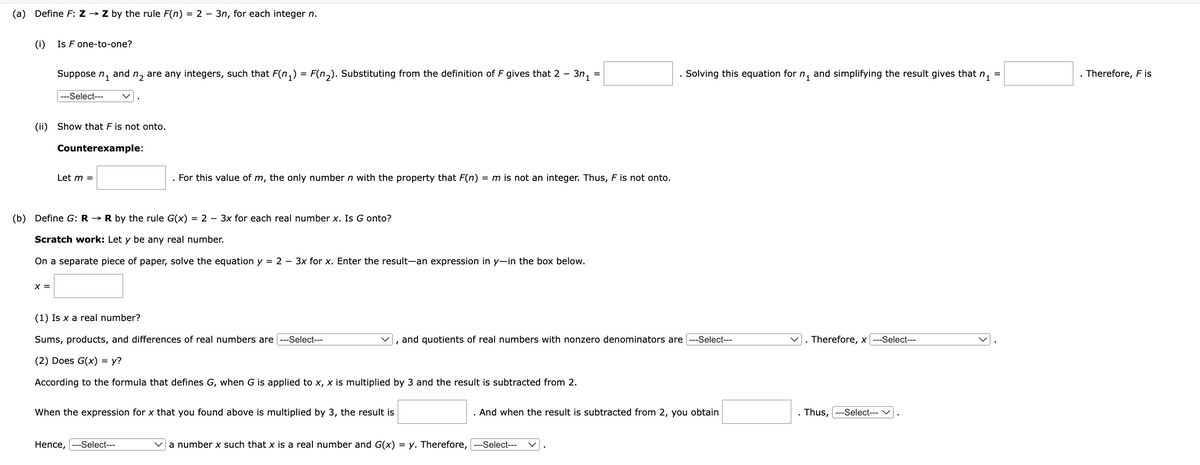(a) Define F: Z → Z by the rule F(n) = 2 - 3n, for each integer n. n1 and n2 are any integers, such that F(n₁) = F(n2). Substituting from the definition of F gives that 2 - 3n₁ = = Solving this equation for n₁ and simplifying the result gives that n₁ = Therefore, F is (i) Is F one-to-one? Suppose ---Select--- (ii) Show that F is not onto. Counterexample: Let m = For this value of m, the only number n with the property that F(n) = m is not an integer. Thus, F is not onto. (b) Define G: R→ R by the rule G(x) = 2 - 3x for each real number x. Is G onto? Scratch work: Let y be any real number. On a separate piece of paper, solve the equation y = 2 - 3x for x. Enter the result-an expression in y—in the box below. x = (1) Is x a real number? Sums, products, and differences of real numbers are --Select--- (2) Does G(x) = y? and quotients of real numbers with nonzero denominators are --Select--- . Therefore, x ---Select--- According to the formula that defines G, when G is applied to x, x is multiplied by 3 and the result is subtracted from 2. When the expression for x that you found above is multiplied by 3, the result is And when the result is subtracted from 2, you obtain Thus, ---Select--- ✓ Hence, ---Select--- a number x such that x is a real number and G(x) = y. Therefore, ---Select---
(a) Define F: Z → Z by the rule F(n) = 2 - 3n, for each integer n. n1 and n2 are any integers, such that F(n₁) = F(n2). Substituting from the definition of F gives that 2 - 3n₁ = = Solving this equation for n₁ and simplifying the result gives that n₁ = Therefore, F is (i) Is F one-to-one? Suppose ---Select--- (ii) Show that F is not onto. Counterexample: Let m = For this value of m, the only number n with the property that F(n) = m is not an integer. Thus, F is not onto. (b) Define G: R→ R by the rule G(x) = 2 - 3x for each real number x. Is G onto? Scratch work: Let y be any real number. On a separate piece of paper, solve the equation y = 2 - 3x for x. Enter the result-an expression in y—in the box below. x = (1) Is x a real number? Sums, products, and differences of real numbers are --Select--- (2) Does G(x) = y? and quotients of real numbers with nonzero denominators are --Select--- . Therefore, x ---Select--- According to the formula that defines G, when G is applied to x, x is multiplied by 3 and the result is subtracted from 2. When the expression for x that you found above is multiplied by 3, the result is And when the result is subtracted from 2, you obtain Thus, ---Select--- ✓ Hence, ---Select--- a number x such that x is a real number and G(x) = y. Therefore, ---Select---
Algebra & Trigonometry with Analytic Geometry
13th Edition
ISBN:9781133382119
Author:Swokowski
Publisher:Swokowski
Chapter4: Polynomial And Rational Functions
Section4.3: Zeros Of Polynomials
Problem 65E
Question
need help

Transcribed Image Text:(a)
Define F: Z → Z by the rule F(n) = 2 - 3n, for each integer n.
n1
and
n2 are any integers, such that F(n₁) = F(n2). Substituting from the definition of F gives that 2 -
3n₁ =
=
Solving this equation for n₁ and simplifying the result gives that n₁
=
Therefore, F is
(i) Is F one-to-one?
Suppose
---Select---
(ii) Show that F is not onto.
Counterexample:
Let m =
For this value of m, the only number n with the property that F(n) = m is not an integer. Thus, F is not onto.
(b) Define G: R→ R by the rule G(x) = 2 - 3x for each real number x. Is G onto?
Scratch work: Let y be any real number.
On a separate piece of paper, solve the equation y = 2 - 3x for x. Enter the result-an expression in y—in the box below.
x =
(1) Is x a real number?
Sums, products, and differences of real numbers are --Select---
(2) Does G(x) = y?
and quotients of real numbers with nonzero denominators are --Select---
. Therefore, x ---Select---
According to the formula that defines G, when G is applied to x, x is multiplied by 3 and the result is subtracted from 2.
When the expression for x that you found above is multiplied by 3, the result is
And when the result is subtracted from 2, you obtain
Thus, ---Select--- ✓
Hence,
---Select---
a number x such that x is a real number and G(x) = y. Therefore, ---Select---
Expert Solution
This question has been solved!
Explore an expertly crafted, step-by-step solution for a thorough understanding of key concepts.
Step by step
Solved in 2 steps

Recommended textbooks for you

Algebra & Trigonometry with Analytic Geometry
Algebra
ISBN:
9781133382119
Author:
Swokowski
Publisher:
Cengage

College Algebra
Algebra
ISBN:
9781305115545
Author:
James Stewart, Lothar Redlin, Saleem Watson
Publisher:
Cengage Learning

Linear Algebra: A Modern Introduction
Algebra
ISBN:
9781285463247
Author:
David Poole
Publisher:
Cengage Learning

Algebra & Trigonometry with Analytic Geometry
Algebra
ISBN:
9781133382119
Author:
Swokowski
Publisher:
Cengage

College Algebra
Algebra
ISBN:
9781305115545
Author:
James Stewart, Lothar Redlin, Saleem Watson
Publisher:
Cengage Learning

Linear Algebra: A Modern Introduction
Algebra
ISBN:
9781285463247
Author:
David Poole
Publisher:
Cengage Learning

Elements Of Modern Algebra
Algebra
ISBN:
9781285463230
Author:
Gilbert, Linda, Jimmie
Publisher:
Cengage Learning,

Algebra for College Students
Algebra
ISBN:
9781285195780
Author:
Jerome E. Kaufmann, Karen L. Schwitters
Publisher:
Cengage Learning